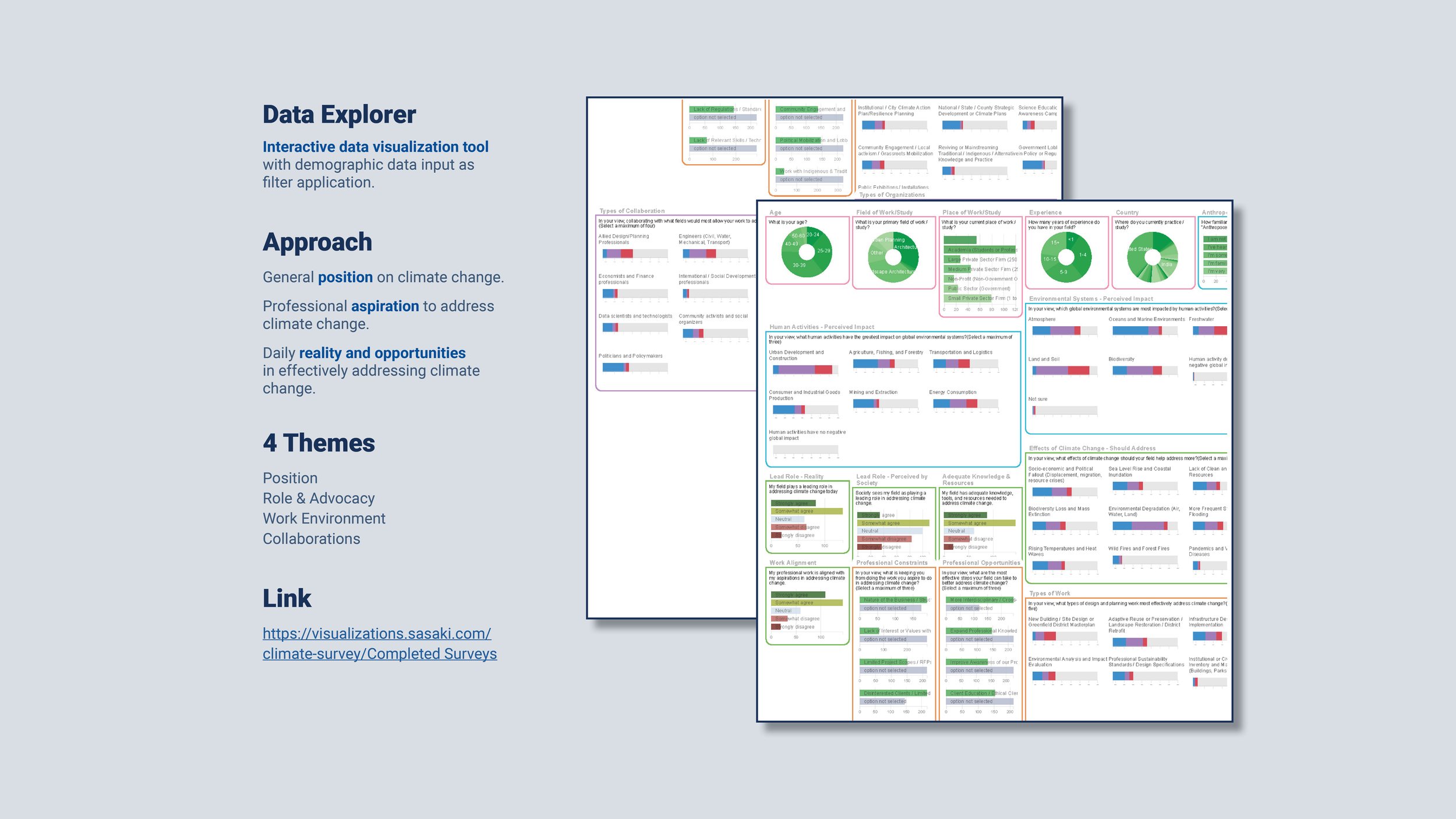Design Climate Survey - Final Report
The Gap between Professional Aspirations and the Reality of Work in addressing Climate Change
April 6th, 2022
By: Justin Kollar, Thomas Nideroest and Sourav Kumar Biswas
There is no shortage of anxiety today. Nearly two years of a global pandemic has disrupted our lives and working situations and yet, climate change is looming larger than ever before. In 2021 alone, the incidence and scope of wildfires along the West Coast of the US and Canada have made records—having burnt through more than three times the area of a typical year for wildfire. The same year, record floods have devastated vast areas in Germany and China. The landfall of Hurricane Henri and Hurricane Ida exposed the climate vulnerabilities of the Northeastern U.S., and the most severe drought of the Southwest has worsened to a degree in which authorities have declared a water shortage on the Colorado River for the first time in history. If these headlines aren’t convincing enough, the 6th IPCC report paints a more dire future for humanity with more frequent and intense precipitation and flooding, longer droughts, and more intense heat waves in the coming three decades as global temperatures continue to rise.
Introduction
Importantly, when it comes to our professional anxieties—in our work as design and planning professionals—we should not resign ourselves to thinking that these are simply matters of our own individual career choices (i.e. not individual anxieties). If the past few years have anything to show us—we (the collective we!) are all in this together—or at least, it is evident that it will take collective action to address the challenges that lie before us. The 6th IPCC report offers a glimpse of hope, stating that humanity still has 10 to 20 years to change course and stabilize global temperatures. However, the proceedings from UN Climate Change Conference in Glasgow (COP26) reveal a political inertia in addressing systemic injustices and transforming modes of production, distribution, and consumption. Impacts of climate change will likely only exacerbate in the coming decades, opening up a range of issues that designers, planners, and allied disciplines have to confront. Thus, it seems appropriate that we critically reflect on our disciplinary status, if only to take stock of how our aspirations are reflected in the reality of our work in addressing climate change. To this end, the International Landscape Collaborative (ILC) developed the Climate Design Survey to shed light on how design and planning professionals feel about their work and the global concerns of climate change. If anything, feelings of anxiety should awaken us to the need for reflection and change, with the hope that this is simply a stepping stone towards broader and more frank dialogue in which our collective anxiety can be turned into collective action.
Fortunately, the planning and design professions have come a long way in taking a more outspoken position on addressing climate change. Prior to the COVID-19 pandemic, several major American professional organizations issued statements to promote action on climate change—the Landscape Architecture Foundation (LAF) inaugurated a New Landscape Declaration while the American Society of Landscape Architects (ASLA) and the American Institute of Architects (AIA) endorsed the Green New Deal resolution. Likewise, the American Planning Association (APA) has taken positions on climate change, even issued a statement on the US withdrawal from the Paris agreement. The American Society of Civil Engineers (ASCE) had also released a list of policies addressing climate change. More recently, professional groups, academia, and grassroots organizations have sought to influence legislators to take steps toward addressing climate change such as the Infrastructure Investment and Jobs Act (H.R. 3684) that passed in the U.S. legislature in late 2021. This political commitment is a first step toward shifting the Overton window in addressing climate change more broadly and providing planning and design professionals with concrete, implementable projects.
These latest events are a call for collective action and an opportunity for planning and design professionals to reflect on the realities of their work and how it measures up to their aspirations to meaningfully address climate change. The goal of the Design Climate Survey, and the findings outlined in this report, is to highlight professional gaps between aspiration and reality of a wide array of planning and design professionals from across the US and around the world.
Overview & Methodology
From Spring 2020 to Fall 2021 responses were collected from a total of 450 respondents across a variety of age groups, fields, places of work, ranges of experience, and places from around the world.
This survey report strategically groups planning and design professionals for a better reading into the survey data and helps us summarize emerging trends - this includes grouping by profession as well as sector. Professional groupings represented in the survey include: 27% for architecture and/or interior design, 41% in landscape architecture, ecology, and/or civil engineering, 20% in urban design and/or planning, and 12% “other” professions such as real estate, sustainability consulting, climate adaptation, and other areas of design and engineering. While 44% of all responses were captured in 41 countries across South America, Europe, Africa and Asia, the majority (56%) is based in the United States.
The following sections elaborate how respondents feel about their work and climate change through each of the survey questions. While there are a few interesting comparisons to be made between fields and sectors, little substantial difference was found across age groups, years of experience, and whether respondents were based in the US or non-US.
Survey Results
Key Takeaways
In early 2020, the ILC invited the international planning and design community to participate in the Design Climate Survey, and published the preliminary results highlighting insights from the pilot survey at Sasaki, a Boston-based planning and design firm. The survey sought to understand how planning and design professionals across the U.S. and the world perceive their role in addressing the threats of climate change and how they aspire to build an environmentally just future. After more than a year of collecting data, the final survey results establish a foundation upon which the design and planning professions might examine their collective aspirations in the climate fight. These aspirations include exploring new models of practice, expanding their value proposition to new clients, cultivating meaningful collaborations, and ensuring their field has a seat at the table with decision makers to take action.
To continue reading the final report, click here:
Explore the Data
The Design Climate Survey was not conceived to statistically evaluate a representative sample of the design and planning professions at large, rather it is a tool to capture our professional positions and aspirations in the context of climate change. However, centering a survey around professional aspirations and the reality of working to address climate change comes with its own challenges. While there is no perfectly agreed-upon way to organize categories, groupings, phrasings, and other ways of presenting information, the final survey language reflects exchanges with professionals at Sasaki where the initial pilot survey was conducted.
There are likely other limitations that have not been explicitly mentioned here, but suffice it to say that we must be realistic with what conclusions we may draw from such a survey. The authors are not without an agenda, therefore this is not an unbiased survey. Likewise, respondents are likely self-selecting as already aspiring to address climate change in their work as is evident in the results. This, however, is part of the intention—we aim to understand how design and planning professionals understand their work and what might be done to achieve the collective aspirations in more effectively addressing climate change. To this end, we also offer our own interpretations and opinions as part of the discussion above.
Would you like to explore the data yourself? No problem! We made the data publicly available on an interactive web-chart. Follow the link below to launch your queries and explore where you might invest in helping to collectively address climate change head on. For more information and inquiries for raw data, please contact us.
Data Explorer - Click Here

















